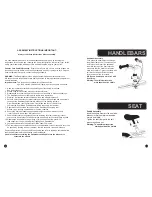
!
i
!
!
!
i
38
39
When making the first fine adjustments, try turning
the adjusting screw counter-clockwise to compensate
for the stretching. Make gradual adjustments with the
adjusting screw. Check the adjustment by shifting one
gear up and then back down. If this is successful, shift
through all gears on the cassette in both directions.
Set the front derailleur so that the chain is able to
run through the derailleur cage without chafing on
the lateral guide plates. Pay attention to the diagonal
position of the chain [ chain line ].
To set the limit stops for your gears, shift to the highest
gear, that is, the smallest rear sprocket, using the small
right shifter. Now look at the derailleur from the back.
The cage of the derailleur and both guide rollers must
be directly under the smallest sprocket.
Use the top limit stop screws to make the adjustment
for the smallest sprocket.
Do the same to set the limit stop for the largest
sprocket. Set the limit stop with the bottom limit stop
screw. Make sure that the chain does not come off of
the largest sprocket into the spokes.
To make adjustments to your front derailleur, use the
adjusting screw on your shifter to set the free chain
line of the front derailleur.
The front derailleur also has two screws for setting
the limit stop. Shift to the small chain ring and adjust
your front derailleur using the inside end stop screw
to prevent the chain from falling off the smallest chain
ring. Switch to the largest chain ring and use the out-
side screw to set the limit stop and adjust your front
derailleur. Do not let the chain come off the chain ring
on the outside.
In addition to setting the chain line, you can set
the limit stops on your rear and front derailleur.
This prevents your chain from coming off the rear
cassette sprocket or the front chain rings.
Make adjustments on a proper workstand. This will
allow you to freely rotate the rear wheel and shift
through all gears.
Location of the limit stop screws to the inner and
outer stop position may differ with the shifter. For this
reason, please be absolutely sure to observe additional
instructions of the shifter manufacturer.
Properly adjusted chain clearance between
left and right limit stop.
If the limit stops are not set
correctly, the chain may fall off and catch between the
chain ring and chain stay or rear cassette and spokes.
The bike will no longer be propelled forward or the
rear wheel may jam as a result. There is a risk of loss
of control or crashing. Exercise utmost care when
setting the limit stops or have this done by a bike
specialist.
We recommend that adjustments to the rear
derailleur and front derailleur should be per-
formed by a specialist. Improper adjustments
may result in mechanical damage.
Please observe
the additional instructions of the shifter manufacturer.
Contact the Porsche Bike hotline if you have ques-
tions.
Improperly adjusted shifter.
Incorrect shifting on
public roads may distract one’s attention from traffic
and potential risks, which may result in an accident or
crash. Check the settings of the shifter during a test
drive away from road traffic.
Bent shifter components.
After a crash, the shifter,
derailleur hanger or front derailleur may be bent.
Proper and safe use can no longer be assured. Have
the defective shifter components replaced by a bike
specialist.
Incorrectly set front derailleur.
The front derailleur
setting is very sensitive. Setting it improperly may
cause the chain to fall off. The bike will no longer be
propelled forward as a result and there is a risk of
crashing. Exercise utmost care when setting the front
derailleur or have this done by a bike specialist.
If the chain falls off, it may cause chain suck
[ deadlock of the chain ] between the front chain
ring and the chain stay. This may damage the
frame.
Exercise utmost care when setting the limit
stops or have this done by a bike specialist.
INFORMATION
WARNING
PLEASE NOTE
PLEASE NOTE
WARNING
WARNING
WARNING
INFORMATION
Derailleur
















































